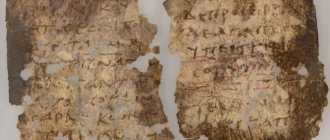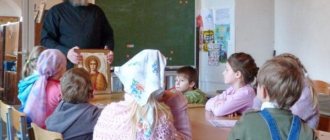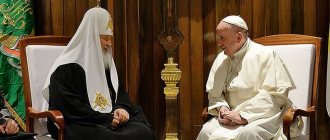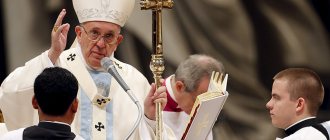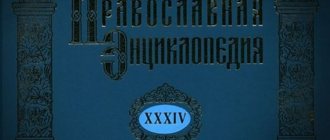Orthodox Christians on the first Sunday of Great Lent - this year it fell on March 17 - after the usual church service, they list all the heretics and proclaim anathemas to them. This is part of the celebration of the Triumph of Orthodoxy. The holiday was established in the 9th century as the day of the final victory of the Orthodox over the iconoclast heretics.
Every church has a list of heretics, and each priest decides for himself how detailed this list should be read. Usually the ritual extends the service by 30-60 minutes. The priests of the cathedrals come out of the altar into the middle of the temple and stand facing the believers. First, those present read a special prayer, then proclaim anathemas against heretics, after which they glorify famous saints of the past.
Why are they anathematized?
Those who teach incorrectly about God are anathematized. The first church-wide anathema was proclaimed in the 4th century to the Alexandrian priest Arius. He argued that Jesus was not God, but merely his creation.
Bishops of some churches in Russia, Ukraine and Greece proclaim anathemas against Protestants, Masons, occultists, Jews and Muslims - that is, all non-Orthodox.
By the middle of the 18th century, the list of people anathematized by the Russian Orthodox Church included more than 4,000 people. Then the list was shortened, leaving only ancient heretics and some political figures (for example, False Dmitry I). Hetman Ivan Mazepa also remained on the list - for betraying Emperor Peter I. In Moldova, where Mazepa died, anathema is still proclaimed to him in the church of the Moscow Patriarchate.
Leo Tolstoy was actually anathematized for criticizing the Russian Orthodox Church. Formally, the church used a different wording: anathema to Tolstoy was not proclaimed in any church, but the Synod issued a resolution, which testified to the writer’s “falling away” from the church - that is, there was excommunication.
Rite of the Triumph of Orthodoxy
Triumph of Orthodoxy
843... The Orthodox world finally overcame the heresy of iconoclasm. In memory of this significant event, a holiday was established, called the Triumph of Orthodoxy. It is celebrated in the first week of Lent. A little later, by the 11th century, a special order was formed that included the dogmas of the Orthodox Church and approved the decisions of seven Ecumenical Councils, and along with this - anathema to all atheists, heretics, as well as persons who were considered traitors to the Fatherland.
The rite constantly underwent changes: the lists of persons subject to anathema expanded due to the constant emergence of new heresies and enemies of the Church. By the end of the 18th century, an opposite trend emerged: the lists began to be shortened, since there were up to 4 thousand names on them!
Interesting fact
By 1869, references to civil criminals, schismatic teachers, and Old Believers disappeared from the rank.
Nowadays, the Rite of the Triumph of Orthodoxy is not church-wide, and the part associated with anathematization is often omitted altogether. According to some priests, this is due to the irrelevance of the anathematisms themselves. Many heresies have become anachronisms, that is, relics of antiquity. In the current situation, when a huge number of new false teachings are emerging, it is a little irrational to mention what happened one and a half thousand years ago and remain silent about modern pseudo-Christian teachings.
How to remove anathema
The decision on removal is made by the Council of Bishops. A positive answer is formalized in a council decision and then a decree is sent to the anathematized person: they say, based on the decision of the Council, the anathema has been lifted from you.
Among the most famous in Europe are the mutual anathemas of the Pope and the Patriarch of Constantinople, which they announced to each other in the 11th century. After this, the church was divided into Orthodox and Catholic. Only in 1965 did Patriarch Athenagoras and Pope Paul VI lift these anathemas.
In 2021, Ecumenical Patriarch Bartholomew invalidated the anathema to the head of the Kyiv Patriarchate Filaret, which the Russian Orthodox Church imposed on him in 1997. In Moscow, rehabilitation was not recognized.
LiveInternetLiveInternet
ABOUT THE RITE OF ORTHODOXY
The Triumph of Orthodoxy is celebrated on the first Week (Sunday) of Great Lent. It was installed in Greece in the 9th century, in memory of the final victory over the enemies of Orthodoxy - the iconoclasts. The doctrine of the veneration of icons, based on St. Scripture and approved by the custom of the first Christians, until the 8th century. remained untouchable. But the iconoclastic heresy, which appeared in Greece itself, spread to many countries. The Church of God suffered persecution greater than that of the pagans. For more than 100 years, the tears and innocent blood of the truly Orthodox were shed, who fought for the right to depict Our Lord Jesus Christ, the Mother of God and saints on icons, as well as to pray to them in front of the icons. These Orthodox Christians were imprisoned, tortured and executed. Honest icons and relics of saints were burned. After the VII Ecumenical Council (787), which consolidated the veneration of icons, there was a weakening of persecution, but only in the middle of the 9th century. The icon venerators were released from prison and imprisonment and returned to their former positions, and the iconoclasts were asked either to abandon their delusion or to cease church service. The Christ-loving Queen Theodora declared: “Whoever does not honor the image of our Lord, His Most Holy Mother and all the saints, let him be cursed!” Methodius, who was elected Patriarch of Constantinople, established a special holiday service at the same time. Orthodoxy was solemnly restored at the service in the St. Sophia Cathedral in Constantinople on the first Sunday of Lent, which fell on February 19 in 843. This is how a celebration and a special rite appeared, called the Triumph of Orthodoxy. In the XII and XIV centuries. this service was greatly expanded by the inclusion of other texts depicting the main tenets of Christianity. This service represents the triumph of the church over all heresies and schisms that have ever existed. It affirms not only the Orthodox teaching on icon veneration, but also all the dogmas and decrees of the seven Ecumenical Councils. Not only icon venerators are blessed, but also all those who live and have gone to the Lord in the faith and piety of their fathers. A special place in this service is occupied by the rite of anathematization. Anathema** is proclaimed conciliarly not only to the iconoclasts, but to all who have committed grave sins against the Church. In Russia, the rite of Orthodoxy was introduced in the 14th century. and consisted of a Greek synodik of this rank, first adding the names of “new heretics”, such as Cassian, Archimandrite of the Yuryev Monastery, etc., then new names were added: Stenka Razin, Grishka Otrepiev, Archpriest Avvakum, many schism teachers, etc.; there were 20 anathematizations, and up to 4 thousand names. At the end of the 18th century. the rite of Orthodoxy was corrected and supplemented by Metropolitan Gabriel of Novgorod and St. Petersburg; From it were excluded both many names to which eternal memory was proclaimed, and the names of many civil criminals and schism teachers. In this form, the Rite of Orthodoxy was published in 1767. The Rite of Orthodoxy was performed in cathedrals after the reading of the hours or before the end of the Liturgy in the middle of the church in front of the icons of the Savior and the Mother of God reclining on a lectern. The rank was significantly reduced in 1801; it listed only heresies, without mentioning the names of heretics. The rank remained without revision until 1869, when the names of state criminals were removed from it. The rite contained the reading of the Creed, the pronouncing of an anathema and the proclamation of Eternal Memory to all defenders of Orthodoxy. The twelve anathemas, as they were pronounced by the clergy in the name of the church before 1917, are given below.
| Twelve anathemas Those who deny the existence of God and assert that this world is original and everything in it without the providence of God and happens by chance: anathema. Those who speak God are not spirit, but flesh; or His not being righteous, merciful, wise, omniscient and similar to blasphemy uttering: anathema. To those who dare to say that the Son of God is not consubstantial and not equal to the Father, so is the Holy Spirit, and to those who confess that the Father, and the Son, and the Holy Spirit are not the same being of God: anathema. Those who foolishly say that for our salvation and for the cleansing of sins there is no need for the coming into the world of the Son of God in the flesh, and His free suffering, death and resurrection: anathema. Those who do not accept the grace of redemption preached by the Gospel, as our only means of justification before God: anathema. To those who dare to say that the Most Pure Virgin Mary did not exist before the Nativity, at the Nativity and after the Nativity the Virgin: anathema. To unbelievers, for the Holy Spirit made wise the prophets and apostles and through them showed us the true path to eternal salvation, and confirmed this with miracles, and now dwells in the hearts of faithful and true Christians and guides them to all truth: anathema. Those who take away the immortality of the soul, the end of the age, future judgment and eternal reward for virtues in heaven, and condemnation for sins: anathema. To those who reject all the holy sacraments contained by the Church of Christ: anathema. To those who reject the councils of the holy Fathers and their traditions, in agreement with Divine Revelation, and piously preserved by the Orthodox Catholic Church: anathema. Those who think that in Orthodoxy Sovereigns are not elevated to thrones by God’s special favor for them and when the gift of the Holy Spirit is anointed to the kingdom for the passage of this great title are not poured out on them: and so to those who dare to rebel and betray against them: anathema. Those who scold and blaspheme the holy icons, whose Holy Church commemorates the works of God and His saints, for the sake of arousing those who look at them to piety, and accept their imitation, and those who say they are idols: anathema. |
In February 1901, the Holy Synod anathematized Leo Tolstoy as preaching: “the overthrow of all the dogmas of the Orthodox Church and the very essence of the Christian faith.” After 1917, the following were anathematized: “those who create lawlessness and persecutors of the faith and the Orthodox Church” (1918), several priests “who publicly blasphemed the Name of God” (1959, 1960). For many decades after the revolution of 1917, the rite of anathematization was prohibited for conciliar proclamation, and the rite of Orthodoxy included only the commemoration of the dead. In the last decade, those who shed the innocent blood of their neighbors in 1993 were condemned. The words of excommunication were pronounced by those who shared the teachings of sects, “new religious movements,” paganism, astrology, etc. (1994). Monk Filaret (Denisenko), who dared to call himself “Patriarch of Kyiv and All Rus'-Ukraine” (1994), was excommunicated from the Church. The Council of Bishops in 1997, after repeated exhortations and warnings about the disorderly wearing of the priestly cross after defrocking, decided: “To excommunicate Gleb Pavlovich Yakunin from the Church of Christ. Let him be anathema before all the people." Anathema is not a curse, it is not an act that irrevocably closes the path to return to the Church and to salvation. With repentance and sufficient grounds, the anathema can be lifted. It may also be removed after death. The abolition of the anathema to Old Believers in 1971 is of great importance for the Russian Church.
WORD OF THE HOLY PATRIARCH OF MOSCOW AND ALL Rus' ALEXI II ON THE WEEK OF THE SOLEPT OF ORTHODOXY, PRONOUNCED IN 1991
My dears!
The Church celebrates the First Sunday of Great Lent as the day of the Triumph of Orthodoxy. Historically, this holiday is associated with the final victory over the heresy of iconoclasm, which for several centuries tormented the Orthodox world. Modern people sometimes think that icon veneration is some kind of special feature in the world of Orthodox theology. And he is perplexed why the victory over the iconoclastic heresy, and not over any other, is called the triumph of Orthodoxy. Iconoclasts argued that God cannot be depicted. The Orthodox fathers, defending the tradition of the Church, placed the veneration of icons in the closest connection with the very foundations of Christianity. Yes, indeed, God is unknowable, inexpressible and indescribable. But He who is above every human word deigned to be born as a man. He who is invisible became visible through the assumption of human nature, and therefore “what was from the beginning, what we have heard, what we have seen with our eyes, what we have looked at and touched with our hands, about the Word of life - for life was revealed... we proclaim you" (John 1:1). “The Word became flesh” (John 1:14), and the Incarnation made the icon possible. And therefore it is possible to be Orthodox without having icons - in recent years we have again lived through the time of the triumph of the iconoclasts, and many had to pray without icons. But one cannot be Orthodox while rejecting icons. Anyone who does not recognize the possibility of an icon denies the very foundations of Christian witness to God who became man. So we see that in the living organism of our Orthodox Church everything is surprisingly unified and proportionate. Everything is interconnected in the living growth of the Church as the Body of Christ. You cannot, according to your private understanding, cut off any branch of the Orthodox Tradition without risking touching the very foundations of our spiritual life. Therefore, it is no coincidence that the day of the celebration of icon veneration is the day of all Orthodoxy. It is no coincidence that the first Sunday of Great Lent is named the Day of Orthodoxy. This day crowns a week of special prayer works. The Greek word “orthodoxy” means both “correct exaltation” and “correct teaching,” that is, it can be translated into Russian not only as “Orthodoxy,” but also as “Orthodoxy.” And it is remarkable that the first meaning of this word was included in the Slavic languages: “Rights of glory.” Doxology, according to the teaching of the Holy Fathers, is the highest level of prayer, for it reveals the pure and unselfish joy of the soul about its Lord. The whole point of spiritual life is to teach a person not just to theology correctly, but to pray correctly. Let us remember how in the Great Canon, which we listened to this week, it was sung that we “orthodoxly magnify” the Mother of God. With this liturgical understanding of Orthodoxy as the ability to correctly glorify the Lord, to correctly build one’s spiritual life, it becomes clear why the day of the Triumph of Orthodoxy falls precisely on today. For when is a person more capable of glorification, if not on this Sunday: we spent the whole week in repentance, in confessing our infirmities before God, and now, having mourned our sins, we nevertheless approach the Chalice, for the Lord “came to call not righteous, but sinners to repentance” (Matthew 9:13). And how can we not thank the Lord for his mercy towards us, how can we not sing the song of the Lord! But Orthodoxy is impossible without Orthodoxy. The history of the Church shows that where the right faith is violated, spiritual life begins to collapse. After all, depending on how people think about God, they create their own ideas about salvation, about the relationship between God and man. And if the teaching about salvation, about the ultimate destiny of man turns out to be erroneous or incomplete, then the spiritual life of a person will turn out to be curtailed and incomplete. Therefore, in dogmatic disputes we are not talking about formulations or theoretical correctness. It is about understanding the very essence of the relationship between God and man and, ultimately, about understanding man himself. And therefore we must not forget the words of the Apostle: “I know in whom I have believed” (2 Tim. 1:12). Today it is extremely important for us to know our faith, because the time of struggle for Orthodoxy is coming again. Many “teachers” and many publications are now inviting the Church to rethink its faith in such a way that the living soul of Orthodoxy will disappear. Some convince themselves and us that Orthodoxy is a kind of national ideology. We must know that Orthodoxy is a search for life in God and that any state and national structure of life is secondary for us. Others say that Orthodoxy is a culture, a kind of “cultural heritage.” We must know that Orthodoxy is not the creation of cultural forms, but the hidden acquisition of the Holy Spirit. Still others argue that Orthodoxy is only one of the historically established forms of Christianity and that it should be surpassed by the fusion of all Christian denominations. We want the unification of Christians not on the minimal basis of our common faith (which in fact will turn out to be the maximum of the unbelief of the Protestant world), but on the utmost fullness of the God-given revelation that was given to the Holy Fathers. After all, in spiritual life one should never look up to the weakest, but, on the contrary, one should always look for more experienced and spiritually richer mentors. Some others come and say that Christ is one of the “teachers of mankind,” just like Buddha, Confucius or Krishna. But we must know that Christ is not just a teacher or a prophet, He is the Lord Himself, who became a man to save people. And He saves us not only by His word and His preaching, but first of all by His Crucifixion and Resurrection and by sending us the Holy Spirit. And therefore we know that anyone who teaches about salvation apart from the Cross and without the Resurrection is not sent from God. Still others are trying to convince people that Christ is either a psychic or an alien. We must resist this crazy preaching with the firm testimony that Christ is God, the Creator of the Universe, who appeared in the flesh “for our sake as men and for our salvation.” My dears! There is no need to think that the time of struggle against false teachings has passed and remains in the distant era of the Ecumenical Councils. And today the Lord calls us to defend the Truth of Orthodoxy from the multiplying preachers of darkness. And He calls on all of you - not only hierarchs and priests, but also the laity, all believers, so that we, to the best of our ability, whether at home, among our friends or at work, defend Orthodoxy. And if some of us do not have the strength and knowledge to conclusively substantiate the impossibility of combining Orthodoxy with the currently reviving paganism and other pseudo-religious teachings, then each of us can still simply warn our neighbors: “People, such and such a false teacher is far from Orthodoxy , and he perjures himself, claiming that he is one with the Church and acts almost with its consent.” But, of course, our main spiritual weapon in defending the Truth is our prayer. If we are truly Orthodox in our spirit, and not just in name, the Lord Himself will help us with His grace. Let us pray for our Church, which is threatened today by false teachings and schisms. Let us pray for our Fatherland, so that it will return to Christ again and so that the adversity that we are experiencing now will not contribute to clouding people’s minds, but, on the contrary, to the enlightenment of their conscience. Let us also pray for ourselves, so that during the remaining days of Great Lent we will succeed in spiritual healing. Let us pray that the Lord will grant us the spirit of true and Orthodox prayer and lead us into the joy of His Resurrection! Amen.
https://www.xxc.ru/orthodox/pastor/torgestvo/
Anathemas in other churches
Until 1983, the Catholic Church also had the practice of proclaiming anathemas. One of its most active users was Pope Pius IX. In 1865, he anathematized rationalists, socialists, communists, the principle of freedom of conscience, and even the rule of separation of church and state.
One of the last anathemas of the Catholic Church was that of Fidel Castro in 1962.
In other faiths they do not anathematize, but rituals of exclusion from the church organization exist. For example, Jehovah's Witnesses are expelled from the congregation, and Scientologists declare an expelled person a “suppressive person.”
In what cases does anathematization occur?
Anyone who deliberately distorts official religious doctrine or rejects the Church as an institution of power, not recognizing its influence over him, but, nevertheless, remaining faithful to its dogmas, can be subjected to anathema. This applies to heretics, false teachers and schismatics.
Anathema is the highest punishment, and therefore is proclaimed only in extreme cases. It must always be preceded by an attempt by the confessor to convince the sinner of his wrongness through instruction and bringing him to repentance.
